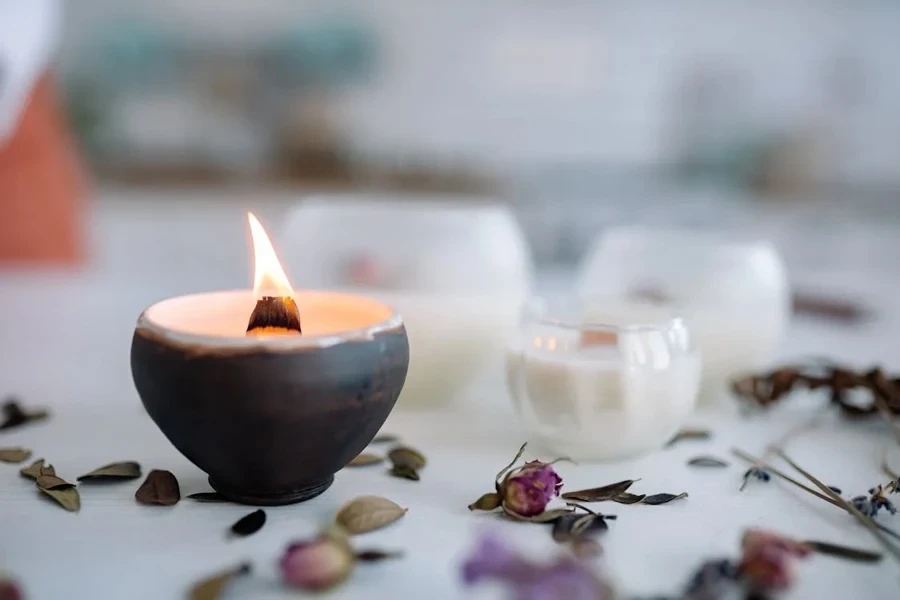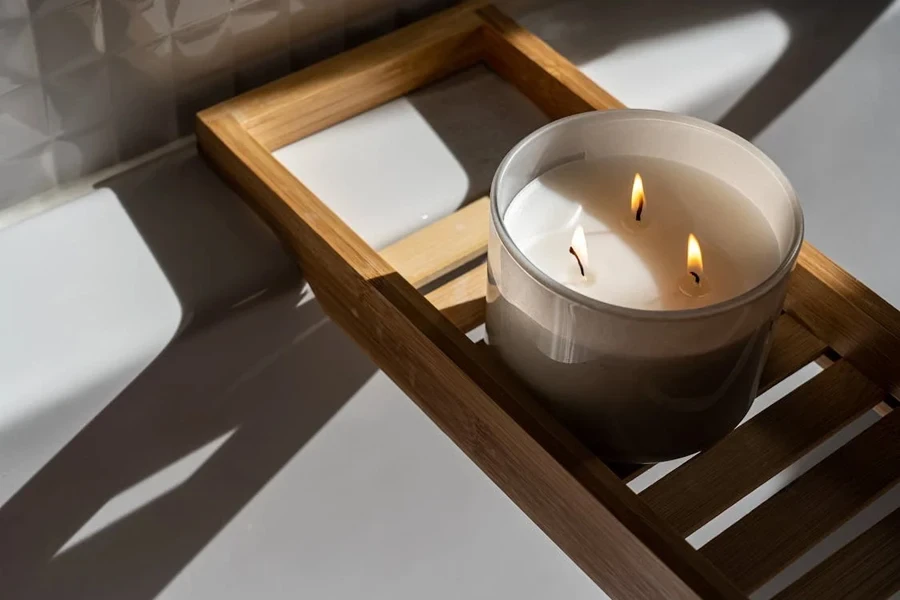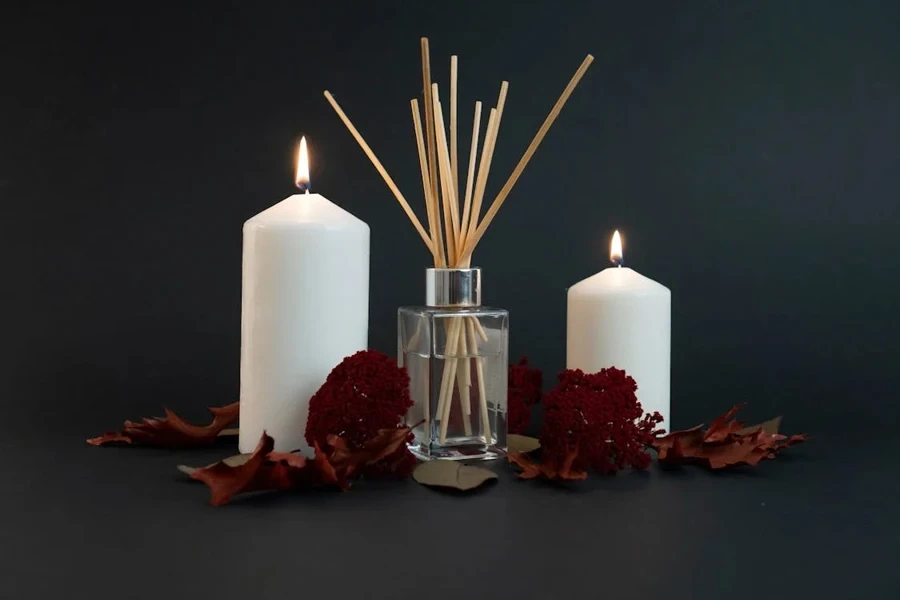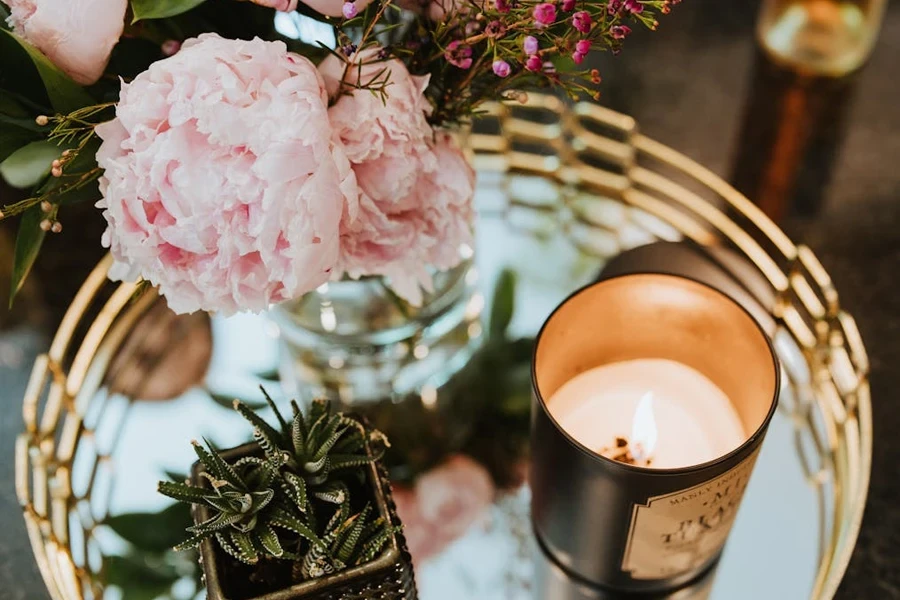Scented candles have become a staple in settings where ambiance and well-being are prioritized. Initially favored for their pleasant aromas, these candles now play a pivotal role in enhancing environments through the strategic use of scent. They offer a dual function: decorating spaces while simultaneously imbuing them with fragrances that can soothe, energize, or focus the mind. As preferences shift towards more natural and health-conscious options, these candles not only cater to the senses but also align with a growing demand for products that contribute positively to personal and environmental health. This trend underscores the significant impact that well-chosen scents can have on the overall atmosphere and experience in any setting.
Table of Contents
1. Candle types and their uses
2. Market insights
3. Selection criteria for scented candles
4. Leading scented candle models of 2024
1. Candle types and their uses

Aromatic varieties
Scented candles enrich environments with diverse aromatic profiles, each tailored to evoke specific sensory responses. Floral scents like rose and lavender offer soothing and relaxing atmospheres, ideal for bedrooms or spas, where a calming influence is desired. Citrus scents, including lemon and lime, inject energy and freshness into spaces, making them suitable for kitchens and living areas where a lively ambiance is beneficial. Woody scents, such as cedarwood and sandalwood, provide a grounding, earthy base that enhances intimate settings or quiet evenings at home.

Wax and wick materials
The choice of wax and wick in a candle significantly influences its performance and environmental impact. Soy wax is celebrated for its clean burn and sustainable credentials, often preferred for its longer burn times and strong scent throw. Beeswax, another eco-friendly option, naturally purifies the air with a subtle, sweet aroma and has excellent burn longevity. Paraffin wax, while popular for its ability to hold scent and color, is less environmentally friendly due to its petroleum base.
Wicks also play a crucial role in candle function. Cotton wicks are favored for their clean burning properties and are commonly used in high-quality candles. They help ensure an even burn, thereby maximizing the candle’s aromatic output without emitting harmful chemicals.
Incorporating these elements thoughtfully contributes to the overall efficacy and appeal of scented candles, aligning with both consumer preferences and environmental considerations. Each material brings its own set of benefits and considerations, impacting the candle’s environmental footprint and the purity of its burn.
2. Market insights

Current market dynamics
The scented candle market is poised for consistent growth from 2024 to 2032, propelled by various factors including an increased interest in home ambiance and wellness. In 2024, the market is estimated to rise from $3.91 billion in 2023 to $4.14 billion, with a projected growth to $5.22 billion by 2028 at a compound annual growth rate (CAGR) of 6.0%. This robust expansion is largely due to the ongoing trends in home décor, the rising emphasis on wellness, and the evolving consumer preferences in fragrances and personalization.

Consumer preferences
There’s a noticeable shift in consumer preferences towards organic and eco-friendly candles, particularly those made from natural waxes like soy and beeswax. This trend is supported by growing environmental consciousness and a preference for products that contribute positively to personal health and well-being. Additionally, the market has seen a surge in demand for unique and luxurious fragrance combinations that cater to a more discerning customer base. Regions like North America and Europe continue to dominate the market due to their high production capacities and established consumer bases.
Overall, the global scented candles market is dynamically evolving with significant contributions from technological advancements in product offerings and deepening consumer engagement through personalization and enhanced shopping experiences, particularly in e-commerce.
3. Selection criteria for scented candles

Scent quality and throw
The effectiveness of a scented candle largely depends on its scent quality and throw, which are critical for providing a pleasing aromatic experience. High-quality fragrance oils are essential for achieving a strong and lasting scent throw. The ratio of wax to fragrance oil must be meticulously balanced to ensure that the scent permeates effectively without overwhelming the space. Moreover, the choice of wax can influence the scent throw; for instance, soy wax is known for delivering a cleaner and more robust fragrance release compared to paraffin wax. To optimize the scent experience, it’s advised to select candles that are designed to match the size of the space where they will be used, ensuring that the fragrance adequately fills the room without becoming stifling.

Burn time and sustainability
Burn time and sustainability are significant factors to consider when selecting scented candles. Burn time is affected by the type of wax, the size of the candle, and how it is burned. Soy and beeswax candles are celebrated for their longer burn times and eco-friendliness. These waxes burn slower and cooler, which not only prolongs the life of the candle but also enhances the sustainability aspect by minimizing waste. Additionally, ensuring a full melt pool on the initial burn can prevent tunneling and extend the candle’s lifespan. Environmental considerations also play a role, with a growing preference for candles made from natural, renewable resources that do not emit harmful byproducts. Proper candle maintenance, such as regular wick trimming and avoiding drafts, can further maximize burn time and improve the overall candle-burning experience.
Incorporating these selection criteria can greatly enhance both the enjoyment and the environmental impact of scented candles, aligning with contemporary preferences for sustainability and quality in home fragrances.
4. Leading scented candle models of 2024

Premium choices
In the realm of premium scented candles, certain models stand out for their exceptional quality and innovation. The Rituals Private Collection, known for its expansive and luxurious aroma profiles, continues to impress with its ability to fill both small and large spaces efficiently. Another notable mention is the Fornasetti Giardino Segreto Farfalle e Balaustra, which captures the essence of an Italian garden with its rich, grassy notes, priced at a premium due to its exquisite design and scent complexity. The Cire Trudon Ernesto candle, with its smoky and leather notes, remains a symbol of luxury, reflecting a historical charm that has appealed across centuries.

Budget-friendly options
For those seeking quality without the hefty price tag, several options provide both affordability and pleasing aromatics. The Beauty Pie candle, crafted in the fragrance capital of Grasse, offers up to 60 hours of burn time, making it a cost-effective choice for continuous comfort. Another excellent option is the M&S Seashells 3 Wick Scented Candle, which combines the freshness of lemon and laundry into a budget-friendly package ideal for gift-giving or personal indulgence. For a unique blend of scents at an accessible price, the Apothecary Large Scented Candle Fresh Start offers an invigorating aroma perfect for enhancing concentration.
These selections highlight the diversity available in the scented candle market, catering to varying preferences and budgets while maintaining a focus on quality and scent experience.
Conclusion
This article has explored the essential aspects of selecting scented candles, highlighting the importance of scent quality, burn time, and sustainability in the market landscape of 2024. From premium models known for their luxurious aromas and thoughtful designs to budget-friendly options that do not compromise on quality or experience, the choices are vast and varied. As the industry continues to evolve with a focus on eco-friendly practices and innovative scents, these insights should guide in making informed decisions that meet both business needs and consumer desires in the coming year.



